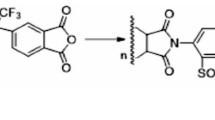Abstract
In recent years, dielectric elastomers became a new alternative in the field of actuation technology. Because of the softness of these materials, they can be deformed in a finite strain regime under the application of electric fields. Due to the low relative permittivity, the electromechanical coupling is weak which makes large electric fields in the range of 20–30 MV/m necessary for large actuation purposes. To overcome this handicap, composite materials consisting of an elastomer matrix with ceramic inclusion have been proposed in the last years. The present work aims at an analysis of the compressive deformation of the composite by a numerical comparison of three inclusion geometries. The results show optimization possibilities regarding the shape of the inclusion which allow for larger dielectric elastomer deformations at lower applied electric fields.








Similar content being viewed by others
References
Carpi, F., De Rossi, D., Kornbluh, R., Pelrine, R.E., Sommer-Larsen, P.: Dielectric Elastomers as Electromechanical Transducers: Fundamentals, Materials, Devices, Models and Applications of an Emerging Electroactive Polymer Technology. Elsevier, Amsterdam (2011)
Shian, S., Diebold, R.M., Clarke, D.R.: Tunable lenses using transparent dielectric elastomer actuators. Opt. Express 21(7), 8669–8676 (2013)
Dorfmann, A., Ogden, R.W.: Nonlinear electroelasticity. Acta Mech. 174, 167–183 (2005)
Dorfmann, A., Ogden, R.W.: Nonlinear electroelastic deformations. J. Elast. 82, 99–127 (2006)
Klinkel, S., Zwecker, S., Müller, R.: A solid shell finite element formulation for dielectric elastomers. J. Appl. Mech. 80, 2:021026 (2013)
Vu, D.K., Steinmann, P.: A 2-D coupled BEM–FEM simulation of electro-elastostatics at large strain. Comput. Methods Appl. Mech. Eng. 199, 1124–1133 (2010)
Ask, A., Denzer, R., Menzel, A., Ristinmaa, M.: Inverse-motion-based form finding for quasi-incompressible finite electroelasticity. Int. J. Numer. Methods Eng. 94, 554–572 (2013)
Xu, B.X., Müller, R., Klassen, M., Gross, D.: On electromechanical stability analysis of dielectric elastomer actuators. Appl. Phys. Lett. 97, 162908 (2010)
Xu, B.X., Müller, R., Theis, A., Klassen, M., Gross, D.: Dynamic analysis of dielectric elastomer actuators. Appl. Phys. Lett. 100, 112903 (2012)
deBotton, G., Tevet-Deree, L., Socolsky, E.A.: Electroactive heterogeneous polymers: analysis and applications to laminated composites. Mech. Adv. Mater. Struct. 14, 13–22 (2007)
Mueller, R., Xu, B.X., Gross, D., Lyschik, M., Schrade, D., Klinkel, S.: Deformable dielectrics—optimization of heterogeneities. Int. J. Eng. Sci. 48, 647–657 (2010)
Klassen, M., Xu, B.X., Klinkel, S., Müller, R.: Material modeling and microstructural optimization of dielectric elastomer actuators. Tech. Mech. 32(1), 38–52 (2012)
Keip, M.A., Steinmann, P., Schröder, J.: Two-scale computational homogenization of electro-elasticity at finite strains. Comput. Methods Appl. Mech. Eng. 278, 62–79 (2014)
Keip, M.A., Schröder, J.: Multiscale modeling of electroactive polymer composites. Ferroic Funct. Mater. Exp. Model. Simul. 581, 263–285 (2018)
Holzapfel, G.: Nonlinear Solid Mechanics. Wiley, Chichester (2000)
Wriggers, P.: Nichtlineare Finite-Element-Methode. Springer, Berlin (2001)
Griffiths, D.J.: Introduction to Electrodynamics. Prentice Hall, Upper Saddle River (1999)
Simo, J.C., Taylor, R.L., Pister, K.S.: Variational and projection methods for the volume constraint in finite deformation elasto-plasticity. Comput. Methods Appl. Mech. Eng. 51, 177–208 (1985)
Brink, U., Stein, E.: On some mixed finite element methods for incompressible and nearly incompressible finite elasticity. Comput. Mech. 19, 105–119 (1996)
Author information
Authors and Affiliations
Corresponding author
Additional information
Publisher's Note
Springer Nature remains neutral with regard to jurisdictional claims in published maps and institutional affiliations.
Rights and permissions
About this article
Cite this article
Klassen, M., Klinkel, S. & Müller, R. Shape optimization of material inclusions in dielectric elastomer composites. Arch Appl Mech 89, 1141–1156 (2019). https://doi.org/10.1007/s00419-019-01540-1
Received:
Accepted:
Published:
Issue Date:
DOI: https://doi.org/10.1007/s00419-019-01540-1




